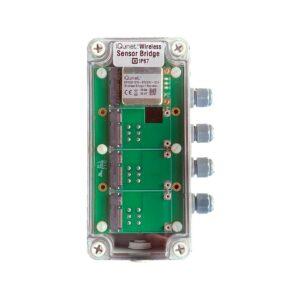- No products in the cart.
- No products in the cart.
Shop
IEPE Vibration Module
€385,38
Synopsis
The iQunet IEPE Vibration Module is an AD-converter interchangeable plug-in module for the iQunet Wireless Sensor Bridge. The module accepts an analog signal from one 1-axial IEPE sensor (IEPE sensor and/or cable not included) and converts the analog IEPE signal to digital, ready for wireless transfer via the Wireless Sensor Bridge.
Description
Description
IEPE Vibration Module
The iQunet IEPE Vibration Module is an AD-converter interchangeable plug-in module for the iQunet Wireless Sensor Bridge. The module accepts an analog signal from one 1-axial IEPE sensor (IEPE sensor and/or cable not included) and converts the analog IEPE signal to digital, ready for wireless transfer via the Wireless Sensor Bridge. The module can thus be seen as a small measuring unit that makes the data compatible with the iQunet system and that makes it possible to set sensor parameters such as sampling rate, number of samples, dynamic range, automatic measurement interval, etc. remotely.
The plug-in module transfers the digital IEPE vibration signal to the Repeater module build into the Wireless Bridge. Sensor data is visualized in the iQunet Sensor Dashboard on the iQunet Data Server, offering time series in acceleration (g) and velocity (mm/s), spectrum graphs in (g) and (mm/s) including waterfall plots, RMS trend values and graphs in (g) and (mm/s), etc.
Used for: the analog to digital conversion of the time waveform and data acquisition of the analog IEPE vibration signal
Technical specifications:
- Physical:
- Dimensions (mm): 43 x 32 x 8
- Weight: 30 g
- Material: EMC shielded PCBA
- Ingress protection: none (to be installed in Wireless Sensor Bridge with IP66/67)
- Installation: fits in to Wireless Bridge connector, fixed with 2 M2x4mm screws
- Operating temperature: -10° to +50°C
- Compliance:
- EMC: EN 301 489-1 / EN 301 489-3
- CE, FCC, KC
- Power consumption: max. 30mA at 24VDC
- Measurements:
- Number of axes measured: for one 1-axis IEPE sensor (wired to Wireless Bridge – up to 3 axes with use of 3 modules)
- IEPE oversampling rate: 1 MHz
- Down sampling rate: 4Hz to 4000Hz
- Number of samples: 32 to 8192 (user selectable via Sensor Dashboard Software)
- Sensitivity: 10mV/g, 100mV/g, 500mV/g, 1000mV/g (user selectable according to used IEPE sensor)
- Amplitude range: depending on selected IEPE sensor
- Units: g or mm/s
- Temperature sensor on board: no
- Postprocessing possibilities (via Sensor Dashboard on iQunet Server):
- Time series, frequency or waterfall plots
- 1/f flicker noise detrending (for velocity spectra)
- DFT averaging for noise reduction
- Trend tracking: RMS or Kurtosis (g and mm/s)
- Configurable high pass cut off filter (0-800Hz)
- Optional: Anomaly Detection Service (based on AI/ML unsupervised learning)
- Start data acquisition (via Sensor Dashboard on iQunet Server):
- Manual trigger (REC button in Sensor Dashboard)
- Automatic measurements (programmable time interval)
- Conditional automatic measurements (programmable threshold level)
- Data storage: on iQunet Server






